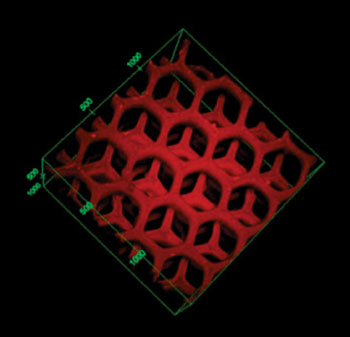Bioprinting 3D Technology Mimics Liver to Detoxify Blood
By LabMedica International staff writers
Posted on 28 May 2014
Nanoengineers have developed a three-dimensional (3D)-printed device to act like the liver to remove harmful toxins from the blood. The device, which is designed to be used outside the body, similar to dialysis, utilizes nanoparticles to trap pore-forming toxins that can injure cellular membranes and are a major factor in disorders that result from stings, animal bites, and bacterial infections. Posted on 28 May 2014
The study’s findings were published May 8, 2014, in the journal Nature Communications. Nanoparticles have already been shown to be effective at neutralizing pore-forming toxins in the blood, but if those nanoparticles cannot be effectively digested, they can accumulate in the liver creating a risk of secondary poisoning, particularly among patients who are already at risk of liver failure. To resolve this problem, a team of investigators, led by University of California, San Diego’s (UCSD; USA) nanoengineering Prof. Shaochen Chen devised a 3D-printed hydrogel matrix to hold nanoparticles, forming a device that mimics the function of the liver by sensing, attracting, and capturing toxins channeled from the blood.

Image: Nanoengineers have developed a 3D printed device inspired by the liver to remove dangerous toxins from the blood. The device, which is designed to be used outside the body like dialysis, uses nanoparticles to trap pore-forming toxins that can damage cellular membranes and are a key factor in illnesses that result from animal bites and stings, and bacterial infections (Photo courtesy of UCSD – the University of California, San Diego).
The device, which is in the proof-of-concept phase, replicates the structure of the liver but has a larger surface area designed to effectively lure and trap toxins within the device. In an in vitro study, the device totally neutralized pore-forming toxins. “One unique feature of this device is that it turns red when the toxins are captured,” said the co-first author, Xin Qu, who is a postdoctoral researcher working in Prof. Chen’s laboratory. “The concept of using 3D printing to encapsulate functional nanoparticles in a biocompatible hydrogel is novel,” said Prof. Chen. “This will inspire many new designs for detoxification techniques since 3D printing allows user-specific or site-specific manufacturing of highly functional products.”
Prof. Chen’s lab has already validated the ability to print complex 3D microstructures, such as blood vessels, in only seconds out of soft biocompatible hydrogels that contain living cells.
Related Links:
University of California, San Diego













